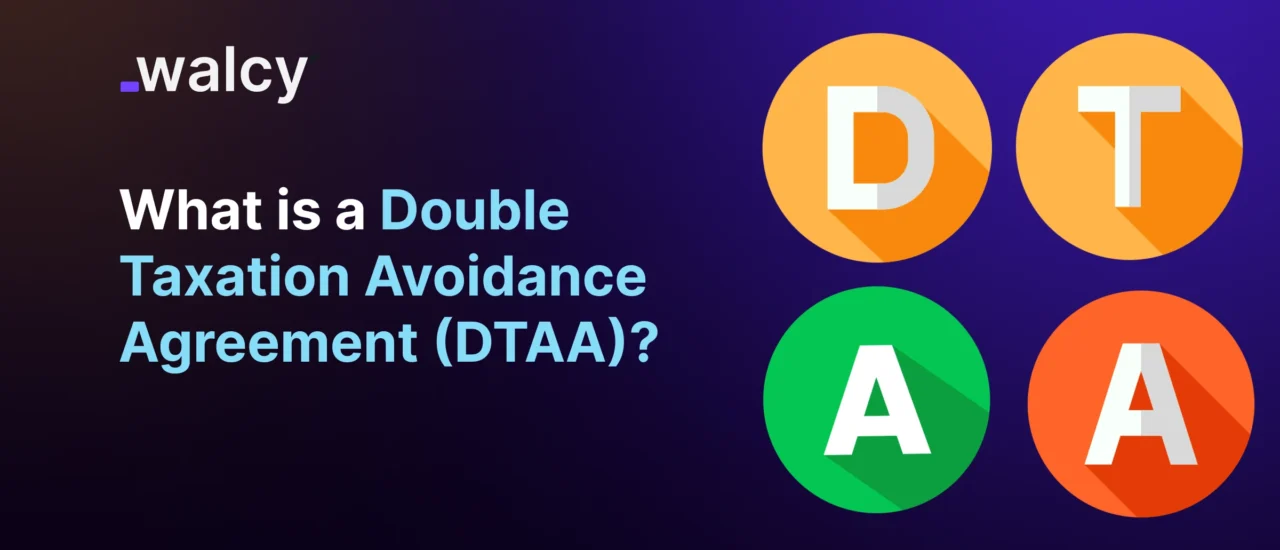In this contemporary world, business transactions span multiple countries transcending borders, where international tax policies are considered a major hindrance or complex contingency that requires careful planning. There is always this tension of paying tax twice or double taxation which renders an individual or a business to pay tax twice in both the countries participating in the transaction process.
Since the same income from trade is taxed twice, once in the country where profit is gained and again in the country where the person resides, several countries have created the Double Taxation Avoidance Agreement (DTAA). Understanding and acknowledging the intricacies of DTAA if one aims to avoid paying tax twice and take charge of their financial decisions.
In this blog, we will explore what DTAA entails, its key benefits, and how to maximize benefits for businesses and individuals. Furthermore, we will present examples of the countries that have DTAA agreements with each other.
What is a Double Taxation Avoidance Agreement (DTAA)?
A double taxation avoidance agreement is a treaty signed between two or more countries that aims to prevent income earned is taxed twice, therefore requiring an inter-governmental level treaty which is complex and is affected by regional politics. Through these treaties, participating countries aim to reduce taxpayers of the burden of paying taxes on the same income in multiple jurisdictions.
The agreement is deemed valuable for ex-pats, international businesses, trading companies, and investors of the foreign exchange domain. This treaty ensures that taxpayers are treated fairly and is a good source of encouragement for fostering cross-border trade and investments.
DTAA enlisted countries to agree on the tax rules governing income. The primary objectives of DTAA are:
- The agreement enforces taxing rights to be dealt with between the countries, which will then reduce the taxpayer’s burden.
- A mechanism is devised to mitigate the need to doubly tax on the same income.
- DTAA also sets limits and with common consensus to a set of tax rates, it segregates income and their respective tax rate, for instance, dividends, royalties, and interests.
Upon signing the DTAA, income-tax bodies can reduce the risk of fiscal evasion, and simplification of tax administration. The aim of every government should be to avoid issues related to double tax as it leads to individuals and companies deterring from paying taxes and engaging in foreign business endeavors.
What Causes Double Taxation
The primary reason would be that there is no existence of DTAA between countries, therefore, not having any way to avoid double taxation. Some of the non-obvious reasons why double taxation might occur include:
- Residence-based taxation: One unfair method of taxation is that some countries often tax their residents on their global income, which is a norm for a US citizen where he might be taxed on income earned abroad.
- Source-based taxation: Another way the tax is realized is when countries tax income generated within their country’s borders, despite the income generated being of a resident of another country. This practice is generally seen in India which tax income earned within India.
- Different tax treatment on the same income: Tax overlapping due to the classification of income begins differently in another country.
For instance, a freelance engineer who lives in Singapore and works for a technology company based in Germany may be subject to tax in both the United States and Germany.
By fostering efficient and comprehensive international collaboration, DTAA resolves all of the aforementioned issues and lowers the tax burden on both people and corporations.
Read about: Make Freelancers Payment; Best Methods and Process (2024)
How Does the Double Taxation Avoidance Agreement Work?
Since DTAA aims to eliminate double taxation, there are three primary methods of how the agreement is enforced:
Exemption Method:
The exempted method entails that the exempted country relinquishes and strictly acknowledges that it has the right to gain income for the tax paid. For example, if an individual earns income in India, and resides in Singapore, only Singapore will have the right to tax the income, while India grants an exemption in this case.
Credit Method:
The tax is paid in the source country, say India, and also in Singapore, however Under the credit approach, the income is taxed in both countries, however, Singapore allows a tax credit for the tax paid in India.
Tax Deduction Method:
Not a common method where the foreign tax paid is considered a deductible expense, which reduces the overall taxable income in the resident country.
There is no one-size-fits-all approach, therefore, usually DTAA agreement includes a hybrid approach where that depends on the type of income, tax provisions, and tax classification in the DTAA treaty. For example, income earned from different income sources such as dividends, interests, remittances, and royalties may be treated differently under a DTAA, this maximizes fairness for the taxpayer.
Key Features of a Double Taxation Avoidance Agreement
Since each DTAA treaty is different between countries, given the history of the country’s trade the treaty is amended and tailored to suit the needs of both countries. Here are some key features commonly found in DTAAs:
Permanent Establishment (PE):
This is to ensure that the business registered is significant enough to be warranted a tax liability and is within their jurisdiction, if it is not deemed significant enough then the income is not taxed in the host country.
Tax Residency:
Tax resident is a term identifies that whether a person or an entity can be considered taxable or not. The Tax residency rules are used to identify whether a person can directly impact how and where taxes are paid.
Withholding Tax Rate:
DTAAs often include confines on withholding tax rates for specific income type.
Capital Gains Tax:
Capital Gains Tax is levied when one gains income from sales of assets and DTAA addresses capital gains tax. DTAA determines in which country capital gains are taxable and reduces the incidence of double taxation on asset sales.
Income Tax Exemptions:
Some sources such as pensions, board of directors’s fees, and salaries are exempted and are separately addressed to avoid double taxation. For example, double taxation is avoidable on retirement income or salaries earned abroad.
Mutual Agreement Procedure (MAP):
MAP is a dispute resolution mechanism within DTAA that allows for consultation between countries to resolve tax conflicts and avoid double taxation issues.
Exchange of Information:
To prevent tax evasion, DTAAs often contain provisions for information sharing between countries, which enhances transparency and allows authorities to track income and assets more effectively.
Benefits of the Double Taxation Avoidance Agreement
The benefits of a Double Taxation Avoidance Agreement extend to individuals, businesses, and the overall economy:
For Individuals, It drastically reduces the tax burden on income earned abroad, ensuring that they don’t pay double taxes. Further, it also increases the disposable income of the individual which allows better savings and investment opportunities. Simplifies tax filing processes and clarifies obligations, reducing stress and avoiding potential penalties.
For Businesses, DTAA ensures there is clarity on tax liability, especially for companies that transcend border, which in return reduces legal and tax risks.
For Countries, More and more businesses are encouraged cross-border trade and investment as it removes the tax barriers. Furthermore, the domestic firms in the foreign market become competitive which prospers the economic growth. Moreover, it helps to attract more foreign investment as after DTA there is a favorable tax environment.
Since there is information sharing, there is more stringent tax compliance, and it discourages tax evasion. Moreover, it can be a catalyst for a stronger bilateral relationship and economic cooperation among the countries bound by the treaty.
Countries with DTAA Agreements: A Look at Some Prominent Examples
Many countries have signed DTAAs, which reflect the country’s specific interests, and below are the examples of the prominent countries that have an allowance for DTAAs:
India: It has DTAAs with over 80 countries, namely, the U.S., the U.K., Canada, Australia, and Germany. Non-residential Indians and migrants are benefitted and companies, especially in sectors like IT and pharmaceuticals.
United States: The U.S. has signed DTAAs with more than 70 countries, which includes its close neighbor Canada, its longtime ally the U.K., and other countries like Japan, and China. Since multinational companies are in abundance from the above-mentioned countries, it is beneficial for the USA.
United Kingdom: The U.K. has the most impressive DTAAs with approximately 130 countries.
Read about: Financial Planning Tips For Non-Resident Indians: Easy Guide
Double Taxation Avoidance Agreement (DTAA) and Tax Planning
From claiming foreign tax credits to residency planning, DTAA provides vast opportunities for better insight into planning tax properly. It is crucial to understand the treaty and tax credit mechanisms, therefore allowing for maximizing tax benefits and reducing tax liabilities. Tax planning entails:
- We urge businesses to use the tax credits, which allow individuals and businesses to reduce their tax burden in their country of residence.
- One can choose which jurisdiction is more familiar and therefore can strategically distribute income, and maximize tax effectively.
- For those who live in multiple countries, understanding the residency rule and its relevant tax policies can reduce tax obligation.
- For individuals who reside in multiple countries, understanding residency rules helps minimize tax obligations.
Steps for Claiming Benefits under DTAA
Taxpayers who wish to take advantage of a DTAA must go through specific procedures, which may be different depending on the country of residence and the terms of the treaty. Here is a general guideline that is recommended:
- Comprehend the Provisions of the Treaty: Go through the DTAA with the country in question to ascertain the benefits due to them.
- Secure a Tax Residency Certificate (TRC): In most instances, a TRC is provided by the tax officials of the country of residence.
- Complete the Necessary Documentation: There are forms and/or application forms, which normally the tax authorities have, for accessing the benefits of DTAA.
- Submit Tax Returns to Both Nations: Notwithstanding the DTAA, there are times when a taxpayer is still required to file returns in both countries to assert tax credits or exemptions.
- Present the Relevant Evidence: Such evidence as income statements, foreign taxes paid certificates, and TRC could be required as supporting documents.
Common Challenges and Misconceptions in DTAA Implementation
We have already understood that DTAAs are good, but there exist some challenges and common misconceptions contrary to this fact.
- Complexity in Compliance: It will be complex to understand the provisions of DTAA more so where different types of income are involved.
- Alteration in Tax Rules: As we know, tax laws get changed from time to time and Thus may affect NDTL practices. To be compliant you need to stay current.
- Unclaimed benefits: Right now the benefits under DTAA are lying unclaimed, burdening taxpayers with unnecessary double taxation.
- Assumption of Relief Automatically: Some individuals wrongfully assume that they are entitled to a double taxation relief by default without following the documentation or compliance rules.
The Future of Double Taxation Avoidance Agreements
Since bilateral relationships are highly complex and it evolved, therefore, DTAAs are also subject to change and are usually influenced by international bodies like OECD (the Organization for Economic Cooperation and Development and the United Nations.
Their primary goal is to induce tax fairness and address global tax challenges and hindrances, specifically for digital economies where remote work and digital nomadism are a common occurrence.
As some countries might get lesser expected benefits, it is increasingly common for countries to renegotiate DTAAs to accommodate new income types, combat tax evasion, and foster information sharing. Therefore, as things shift fast with DTAA taxpayers need to stay informed about new provisions which could affect their tax obligations.
Conclusion
In a nutshell, the thing is that the Double Taxation Avoidance Agreement is one of the most important tools in the world of international taxation and it does provide protection for taxpayers.
It also contributes toward international cooperation and economic development. Furthermore, these agreements provide, in essence, relief from having to pay tax twice on the same income.
Another benefit is that they credit the taxes that have already been paid and set maximum limits for other taxes, which ensures everything is fair and more efficient all around not just for individuals working abroad, or international companies, but also for somebody taking part in the transaction of funds or enterprises in foreign markets, knowledge about DTAA can help save many amounts of money spent or litigation costs.
Shortly, as the global economy grows substantially, and financial transactions become complicated and connected, this will make DTAAs another complement in choosing how to estimate and measure tax.
Read about: All About Overseas Payments (2024); Comprehensive Guide
Do follow us on Facebook and LinkedIn, to stay connected with us.



